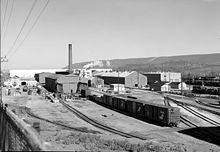Built/founded 1850–1925 | PA marker dedicated October 5, 1996 | |
 | ||
Governing body/owner | ||
Altoona works turntable action ns2102 shifts ns6918 april 1st 2016
Altoona Works is a large railroad industrial complex in Altoona, Pennsylvania. It was built by the Pennsylvania Railroad (PRR) to supply the railroad with locomotives, railroad cars and related equipment. For many years it was the largest railroad shop complex in the world.
Contents
- Altoona works turntable action ns2102 shifts ns6918 april 1st 2016
- Nickel plate road 765 passes the altoona works on memorial day 2013
- History
- Current facilities
- Major facilities 1920s
- References
Nickel plate road 765 passes the altoona works on memorial day 2013
History
In 1849, PRR officials developed plans to construct a repair facility at a town newly established for this purpose, Altoona. Construction was started in 1850, and soon a long building was completed in the 12th Street area that housed a machine shop, woodworking shop, blacksmith shop, locomotive repair shop and foundry. This facility was later torn down to make room for continuing expansion. Many additional buildings and facilities were added to the complex up until 1925. For many years it was the largest railroad shop complex in the world.
The 12th Street area facilities were replaced later by the Altoona Machine Shops. The first locomotive was built there in 1866. A total of 6,783 steam, diesel and electric locomotives were manufactured in Altoona between 1866 and 1946.
In time additional PRR repair facilities were located in Harrisburg, Pittsburgh, and Mifflin, and the Altoona Works expanded in adjacent Juniata. Inventor Alexander Graham Bell sent two assistants to the Altoona shops in 1875 to study the feasibility of installing telephone lines.
In 1875 the Altoona Works started a testing department for PRR equipment. In following years, the Pennsylvania Railroad led the nation in the development of research and testing procedures of practical value for the railroad industry. Use of the testing facilities was discontinued in 1968 and many of the structures were demolished.
In May 1877, telephone lines were installed for various departments to communicate with one another.
Fort Wayne, Indiana, also held a key position for the railroad. By the turn of the 20th century, its repair shops and locomotive manufacturing facilities became known as the "Altoona of the West."
In the 1920s the site consisted of 125 buildings on 218 acres (0.88 km2), and the shops employed over 16,000 workers. Portions of the complex are still in use by Norfolk Southern Railway (NS).
By 1945 the Altoona Works had grown to be one of the largest repair and construction facilities for locomotives and cars in the world. During World War II, PRR facilities (including the Altoona Shops) were on target lists of German saboteurs. They were caught before they could complete their missions.
Current facilities
The locomotive shop at Juniata is currently operated by NS with approximately 1,100 employees. The Railroaders Memorial Museum is located adjacent to Altoona Works.
